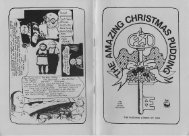You also want an ePaper? Increase the reach of your titles
YUMPU automatically turns print PDFs into web optimized ePapers that Google loves.
PINK FLOYD CD DISCOGRAPHY<br />
Notes on CD discography<br />
by Hans Gerlitz<br />
CD DISCOGRAPHY<br />
This discography includes the official releases of Pink<br />
Floyd albums and albums from the band members,<br />
singles, promotional and related issues on CDs.<br />
Counterfeits, pirates and bootlegs are not included.<br />
The discography is divided into three parts.<br />
Basic Discography: Here you will find the listings of<br />
all albums, singles and promos and general<br />
information about every album, including track listing,<br />
duration, release date and album credits. Even<br />
albums that were only released as vinyl are listed<br />
here. CDRs are not included.<br />
The Main Part of the discography contains all known<br />
editions of albums, singles, promotional issues and<br />
<strong>com</strong>pilations subdivided into country of appearance.<br />
Every edition is ac<strong>com</strong>panied by pictures of front- and<br />
back cover as well as the CD. Pink Floyd albums are<br />
listed separately from solo albums. European editions<br />
are summarized, Asian countries are listed<br />
separately, but clustered in one chapter.<br />
The Appendix and Overviews covers miscellaneous<br />
<strong>com</strong>pilations. In Appendix you will find editions which<br />
are not listed in the main part, such as band<br />
member´s guest appearances, CDR issues, radio<br />
shows etc. Overviews list the editions of special<br />
interest like MFSL CDs or mini LP replicas which are<br />
gathered together in one chapter, and with additional<br />
pictures of the content. The Overviews chapters are a<br />
repetition of already listed items in the main part of<br />
this discography.<br />
The sequence of this discography does not always accord<br />
to the actual sequence of the editions. Some editions were<br />
released almost simultaneously, for others the necessary<br />
information to date the releases are missing.<br />
Every chapter lists the albums in chronological order<br />
according to the year of the original album releases.<br />
As a matter of principle the original (not remastered)<br />
editions are listed first, followed by the remastered editions<br />
from the nineties. Particular first editions are put out as<br />
such.<br />
Chapters covering the solo works first register Syd Barrett<br />
and then David Gilmour, Nick Mason, Roger Waters and<br />
Richard Wright. It also applies here: The editions within the<br />
artist's work are listed chronologically according to the year<br />
of the original album releases.<br />
In the Appendix ‘Guest Appearances’ you will find a sorting<br />
of interpreters prior to the chronological sorting.<br />
The pages of the discography are not paginated. The<br />
discography is made for double-sided printing.<br />
The discography is a reference guide, not a book on the<br />
artwork of Pink Floyd. The photos of the artworks are used<br />
solely for the purposes of distinguishing the differences<br />
between the releases.<br />
CD Format<br />
The format of an audio CD (Compact Disc<br />
Digital Audio) is described in a so called Red<br />
Book produced in 1980 by the format creators<br />
Sony and Philips. The format is a two-channel<br />
16-bit PCM encoding at a 44,1 kHz sampling rate. The<br />
selection of the sample rate was primarily based on the<br />
need to reproduce the audible frequency range of 20Hz -<br />
20kHz. The main parameters of the CD are as follows:<br />
- Disc diameter 120 mm<br />
- Disc thickness: 1,2 mm<br />
- Centre spindle hole diameter: 15 mm<br />
- Weight: 16 grams<br />
- Scanning velocity: 1,2–1,4 m/s (constant)<br />
- Playing time: 80 minutes<br />
The first Compact Disc for <strong>com</strong>mercial release (not a Pink<br />
Floyd album) rolled off the assembly line on August 17,<br />
1982, at a Philips factory in Langenhagen, near Hannover,<br />
Germany.<br />
CD Manufacturing<br />
A CD is made from a disc of almost pure polycarbonate<br />
plastic. A thin layer of aluminum or gold is applied to the<br />
surface to make it reflective, and is protected by a film of<br />
lacquer.<br />
The clear plastic part of the disc is produced using a<br />
hydraulic press. After the metallic layer is applied to the<br />
clear substrate, the disc goes under a UV light for drying.<br />
To press the CD, first a positive glass master is cut using a<br />
high-power laser. After testing, it is used to make a die by<br />
pressing it against a metal disc. The die then be<strong>com</strong>es a<br />
negative image. In next step the die goes into the press<br />
and the image is pressed onto the blank CD, leaving a final<br />
positive image on the disc. A small circle of lacquer is then<br />
applied as a ring around the centre of the disc, and a fast<br />
spin spreads it evenly over the surface. The disc can then<br />
be printed and packed.<br />
CD data is stored as a series of tiny indentations known<br />
as ‘pits’, encoded in a tightly packed spiral track moulded<br />
into the disc. The areas between pits are known as ‘lands’.<br />
Each pit is approximately 100 nm deep by 500 nm wide,<br />
and varies from 850 nm to 3.5 µm in length.<br />
The recording technology is identified mostly on the back<br />
cover or on the CD by a three-letter code:<br />
AAD: analogue tape recorder used during session<br />
recording and subsequent mixing and/or editing,<br />
digital recorder used during mastering (transcription).<br />
ADD: analogue tape recorder used during session<br />
recording, digital recorder used during subsequent<br />
mixing and/or editing and during mastering<br />
(transcription).<br />
DDD: digital recorder used during session recording,<br />
mixing and/or editing and mastering (transcription).<br />
Matrix Number and SID Code<br />
Like the catalogue number and the barcode (EAN, UPC<br />
and IAN code), the matrix number is an additional<br />
information which can be found on the CD. The matrix<br />
number is engraved characters located around the inner<br />
circle of a CD. These characters are used by the factories<br />
at the stages of pressing records. Several CDs<br />
manufactured in the same series usually have exactly the<br />
same matrix numbers.<br />
Some record collectors have extended the term “matrix<br />
numbers” to apply to the <strong>com</strong>plete alphanumeric codes<br />
engraved around the centre of the CD. These codes<br />
contain not only the matrix-number but also some<br />
Information, like for example the Code 39 (same as the<br />
usual barcode) as well as the so called SID Code (Source<br />
Identification Code).






